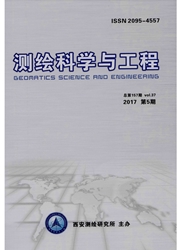

 中文摘要:
中文摘要:
根据卫星高度计定标中GNSS浮标测量海面高的精度需求,研究了浮标天线参考点高(简称天线高)受温盐度变化的影响。推导了浮标天线高随水体密度变化的计算公式,计算了不同海水温盐度条件下天线高的变化,分析了在淡水条件下标定浮标天线高的有效性,讨论了近岸测量与浮标布设区域测量温盐度不同对天线高改正的影响。结果表明:当水温在0~400C、盐度在0—40%。范围内变化时,浮标天线高相对于原标定结果可能有最大约3—4mm量级的变化,在高度计定标过程中有必要对天线高进行改正;在淡水条件下对天线高进行标定是可行的,该标定结果在实际应用时必须经过改正;当浮标布设区域与近岸海域温盐度相差分别不超过±5℃与±5‰时,可以通过在近岸海面测得的海水温盐度计算布设点处天线高的改正量。
 英文摘要:
英文摘要:
According to the accuracy requirement of GNSS buoy to measure the sea surface height (SSH) in satellite altimeter calibration, the influence of seawater temperature and salinity on the antenna reference point (ARP) height of GNSS buoy is studied. The formula for revealing the relationship between ARP height and water density change is derived and used to calculate height changes in different conditions of temperature and salinity. The validity of the calibration of ARP height in freshwater is analyzed, and the influ- ences of different seawater temperature and salinity measured respectively in nearshore and buoy deployment areas on ARP height cor- rection are discussed. The results show that the ARP height has a maximmn change of 3 -4 mm compared with the calibrated height when the water temperature varies from 0 to 40℃ arid salinity varies from 0 to 40%0, and it is necessary to correct in altimeter calibra- tion; it is feasible to calibrate the ARP height in freshwater, and the calibrated height must be corrected in practical application; when the temperature and salinity differences between the nearshore and deployment areas are within ±5℃ and ±5‰, the ARP height correction in the deployment place can be calculated with the temperature and salinity of nearshore seawater.
 同期刊论文项目
同期刊论文项目
 同项目期刊论文
同项目期刊论文
 Construction of least squares collocation models for single component and composite components of di
Construction of least squares collocation models for single component and composite components of di 期刊信息
期刊信息
